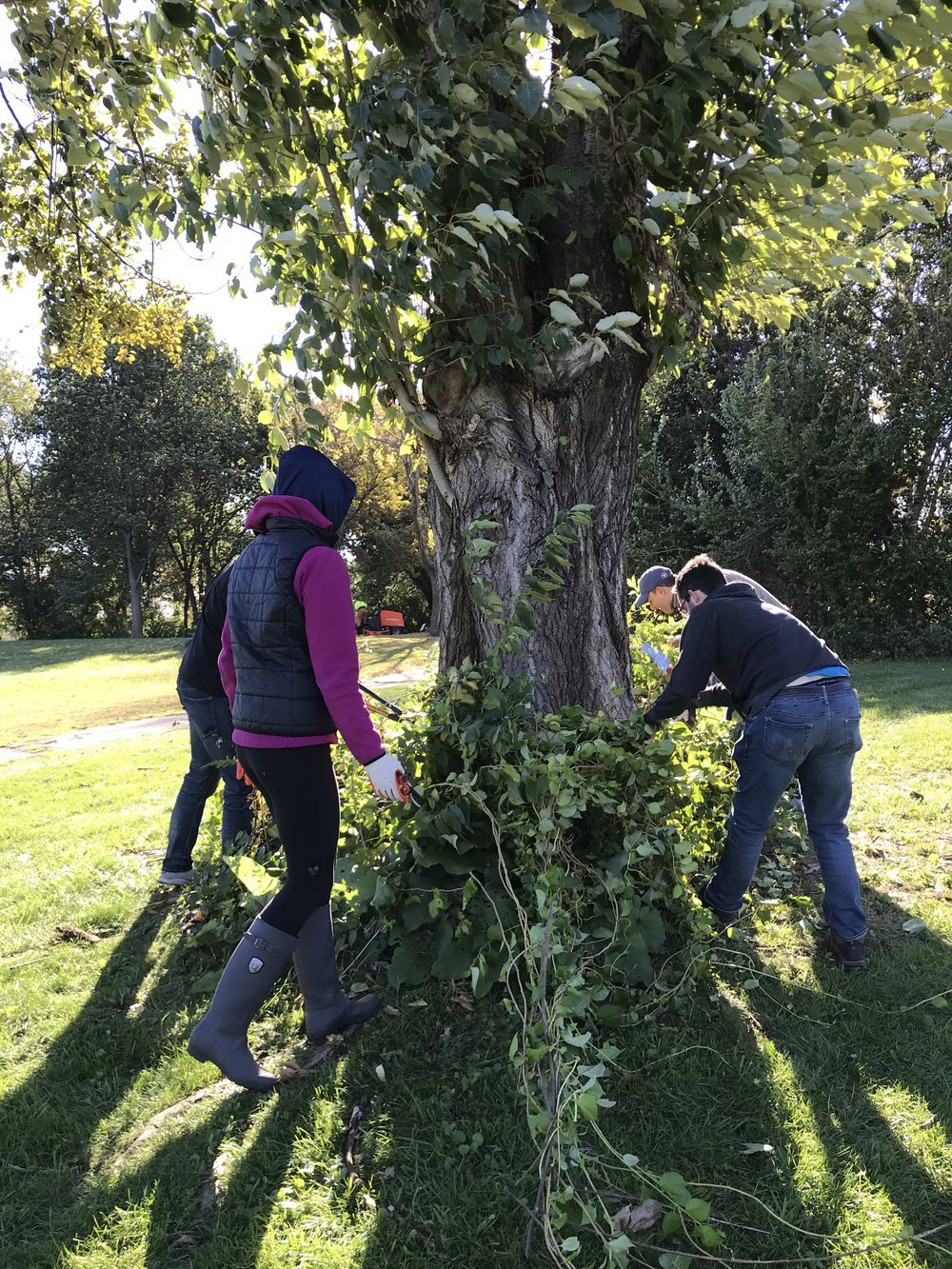INVASIVE PLANTS
Volunteers remove water chestnut from the Mystic River. Photo: MyRWA
The Mystic River Watershed Association runs two volunteer-powered invasive plant management programs, one tackling the aquatic plant water chestnut and a second program removing Oriental bittersweet from waterfront parks. Hundreds of volunteers participate in these programs each year, significantly improving the health and aesthetics of the river.
Volunteer
Volunteer opportunities run from monthly from June - November.
Corporate Opportunities
Join the list of companies who make a difference in the Mystic! MyRWA can organize a fun and rewarding employee community service day for you. Learn more about our corporate volunteer opportunities.
What are invasive plants?
Invasive plants are defined as those that are not native to North America, have naturalized in the environment, and are harmful to native ecosystems. There are plenty of plants — like Queen Anne’s lace — that are not native, but live in relative harmony with native plants.
Invasives, on the other hand, outcompete and ultimately kill native plants. Why is that bad? Isn’t one green plant as good as another?
Actually, native plants support much richer food webs. Oak trees, which are native in North America, support 500 species of moth and butterflies. While Norway Maples, a widely planted city tree, host no moths (or close to none). To birds a Norway Maple is a food desert; while an oak tree is a feast.
The Mystic River Watershed Association works to remove invasive species, including Oriental Bittersweet and Water Chestnut.
Oriental Bittersweet
Volunteers remove bittersweet vines from a tree.
The case against Oriental Bittersweet is simple: it kills trees. Oriental bittersweet (Celastrus orbiculatus) is a leafy, climbing woody vine and was introduced to the eastern United States in the mid-1800s. It is native to China, Japan and Korea. Stems of older vines can be up to 4 inches thick and climb over 60 feet. As Oriental bittersweet grows, it chokes or girdles the plant that it is clinging to, shades out other plants and makes trees top-heavy, making them susceptible to wind and ice damage.
Its leaves vary widely in shape and can be round, oblong, or teardrop shaped with finely toothed margins and sometimes a long, tapering point. Leaf length ranges from 2-5 inches long and 2-3.5 inches wide. They are glossy green in spring and summer, becoming golden yellow in late summer and fall. It is easily identifiable in the fall by its red and orange berries.
Water Chestnut
A water chestnut plant on the Mystic River. Photo: MyRWA
Eradication efforts of water chestnut, an invasive plant clogging the Mystic River and elsewhere in the watershed, have been ongoing since 2010. MyRWA is aggressively combating water chestnuts by partnering with municipalities, local environmental organizations, boat clubs, corporations, and community members to remove the plant by hand-pulling and a mechanical harvester where location permits. Because of our work, the volume of water chestnut in the river has drastically decreased! Check out a time-lapse video of volunteers in action.
Water chestnut (Trapa natans) is native to Asia, Europe, and Africa. It was introduced in 1897 by a Harvard botanist as an ornamental plant in Fresh Pond in Cambridge. Water chestnuts spread over the rivers surface, crowding out native plants and altering the water chemistry. In the fall when the plants die, their decomposition draws down the dissolved oxygen which fish and other aquatic animals need to survive. Additionally, the plants get caught in motor boats and limit the use of the river. If we don’t remove water chestnuts, they will take over the fresh water portion of the Mystic River! The plant has a floating rosette of leaves with spiky seeds, or nuts, just beneath the leaves.
It’s important that we pull these plants before they have a chance to reproduce so that we diminish the seed bed. Check our volunteer page in the summer for invasive species removal events!
THANKS TO THE MANY HELPING HANDS THAT MAKE THIS WORK POSSIBLE!
2023: 1,343 volunteers removed 1467 baskets of water chestnut, 327 bags of Bittersweet, and 502 bags of trash.
2022: 1,303 volunteers removed 2,555 baskets of water chestnut, 388 bags of Bittersweet, and 727 bags of trash.
2021: 679 volunteers removed 2,477 baskets of water chestnut, 120 bags of Bittersweet, and 296 bags of trash.
2020: Within the constraints of COVID-19, a dozen volunteers cleared Torbert Macdonald Park of Oriental Bittersweet through regular visits, while 30 volunteers removed water chestnut along the banks of the river in Medford.
2019: 1,535 volunteers removed 4,529 baskets of water chestnut, 1,000 bags of Oriental Bittersweet and 100 bags of trash.
2018: 793 volunteers removed 2,403 baskets of water chestnut and 1,850 lawn bags of Oriental Bittersweet.
2017: 996 volunteers removed 5,200 baskets of water chestnut and cleared 18 acres of parkland of invasive plants.
2016: 835 volunteers attended 22 events, removing nearly 67 tons of plant material from the Mystic River and Arlington Reservoir.
2015: 966 volunteers hand-pulled 94,160 lbs. of water chestnuts across 21 events.
2014: 941 volunteers attended 19 events removing 6,603 baskets of water chestnut, clearing 2.3 miles of the Mystic River.







